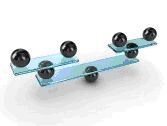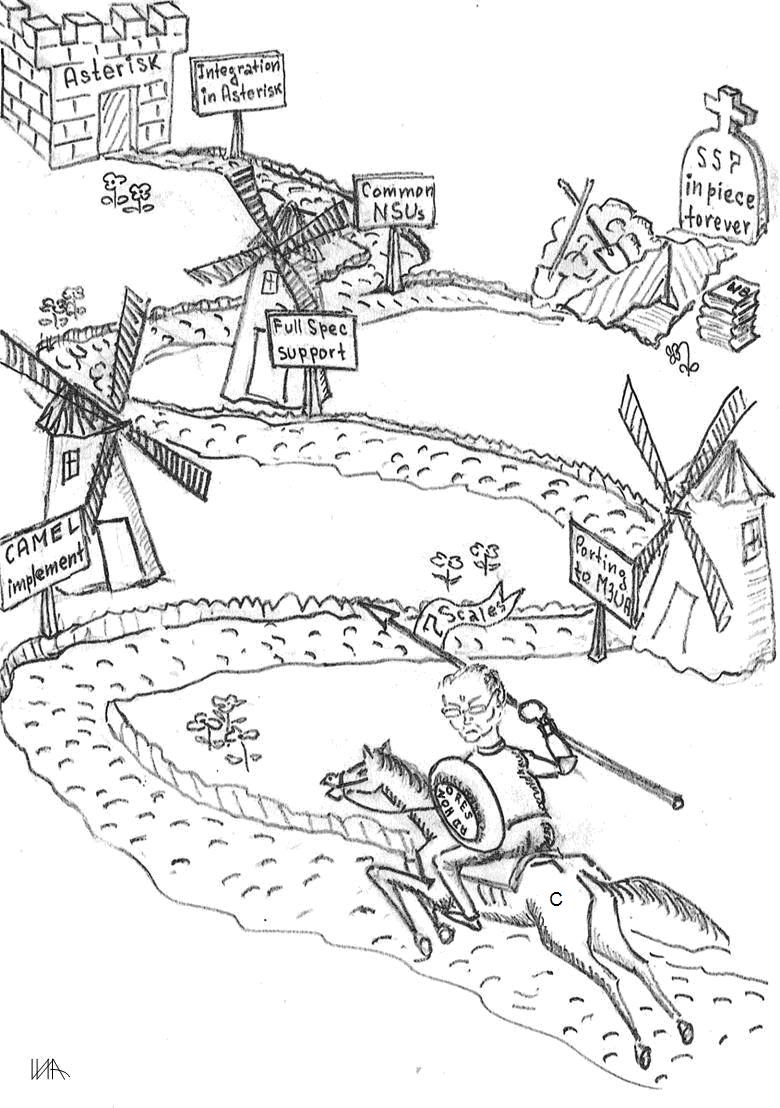
 |
Fig. 5.1 presents the roadmap of the 7-Scales project using the famous scene of the great Cervantes´ novel about Don Quixote, to stress that the author has started a project devoted to a great but waning era in Telecommunications - the one of TDM/ATM technology and the Signalling No.7.
The first windmill to battle with, the CAMEL implementation, is actually a simple exercise that the author has planned for the Christmas holidays of Year 2012. It comprises creation of header files cap_base.h and cap_opdefs.h. The first header file is produced by an Excel table empowered with some VBA code and requires 2-4 hours to collect the input data. Initially the second header file will contain only the most used operatimons - InitialDP, Continue, Connect, RequestReportBCSM, EventReportBCSM and Release and will be extended as the needs come from the fields. Such needs will certainly come in the upcoming year as there are plans to use extensively CAMEL in the network the author works in. This will be Release v0.3.x of 7-SCALES, where x is growing together with the grownt of xxx_opdefs.h headers, acquiring more and more Operations.

The next windmill in the up-road is to port 7-Scales to M3UA, the most widespread transport protocol above SCTP. The author doesn´t like M3UA as it mixes primitives with messages. However, there are many advantages of using M3UA and here the author would be happy to welcome enthusiasts to would join the party. With the acquisition of M3UA, the Code will be published under its first official Release, v1.0. This is going to be the official birth of the project.
It is obvious that without call establishment mechanism the 7-Scales project will be dead-born. The shortest way to obtain this vital functionality is to be integrated in Asteriks, if this matches well to the plans of Asteriks´ developers. With this objective in mind the next windmill to overcome is to develop functionality to support MAP, INAP and CAP Specs in full. This means that all operations are acquired (have complete static thisIE structures) and functions to process all types of I.E. are available (functions for some basic I.E. types are developed already). A functionally to build messages from scratches has to be available in the Code as well. This is a huge undertaking and requires a software tool that reads Specs and produces static thisIE structures for the operations, a kind of ASN.1 parser. The memory management needs to be changed and the NSU process has to be removed. Simulation mode will be abandoned. Instead of children processes created by fork(), the thread technique is to be used. All these are preconditions to attempt to integrate 7-Scales into Asteriks. If ever happen, this will be Release v2.x.x. Double x´s are reserved for numbering the consecutive steps as this will not be finished for a night and by a single person.
If ever reached, at this moment of its life the 7-Scales project will be ready for development of a common NSU to simulate the network and save scenario development efforts for the NSU process. It is not feasible that a single NSU can accommodate all the functionality of the network. The objective at this point is to have a limited number of NSU functions, which simulate different aspects of network functionality, giving the users opportunity to choose the one that matches best to their needs. If that ever happen, it will be Release v3.x.x and is considered to be a long process as well.
Nothing is as certain as the final stage of this project, its phase out. One day the 7-Scales will be buried at the bottom of author´s hard disk. This is inevitable, but the author hopes not to be alone at this funeral. The project is open for anyone and anyone´s contribution will be noted and respected should he or she notes and respects contributions of the others. As with the windmills it is not the result that matters but the way we achieve it for the challenges and the good time.
These are universal principles to which the Citizens of the Universe will ever adhere to...
Back to top Back to Contents